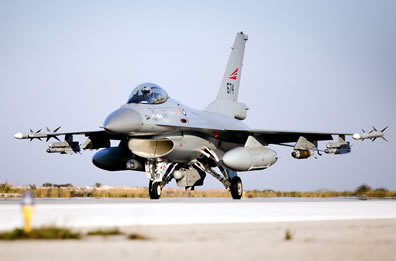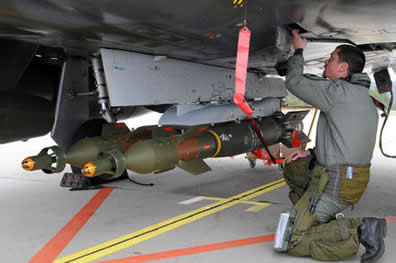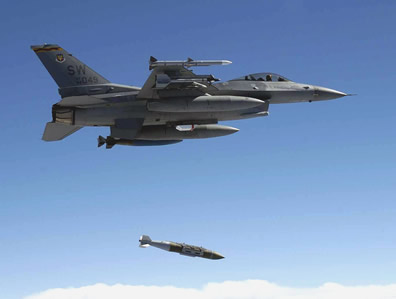
This is a page 2 of a three page article: 1 – 2 – 3
Laser Focused Strike
Laser guided bombs employ guidance kits enabling the weapon to home in on laser spots illuminating the target, designated by the launching aircraft, another platform or ground designator. The laser guided bombs are highly suitable for the North African, Afghan and Middle-Eastern environments, given the cloudless sky, good visibility and clear night sky over the desert. Laser guided weapons are often more accurate than geo-targeted weapons, typically achieving circular error points (CEP) of thee to one meters, depending on the type of guidance used.

Several companies are offering various types of laser guidance kits for aerial bombs. The most common is the Paveway system, originated in the 1970s, now at its fourth generation. Paveway II is the common, low cost system, employed mostly with medium weight bombs (500 1and 1000 pounds).
The high accuracy and relatively low cost of laser guided weapons make them attractive for many users. Yet, low cost comes at a price – mission effectiveness and versatility. On the down side, the employment of laser guided weapons requires complex coordination. Since the weapon itself has no communications link, every element in this complex setup has to be in place prior to launch, for the weapon to hit the right target. Exclusive reliance on laser homing also restricts the weapon’s operations under adverse weather conditions and exposes its vulnerability to smoke and countermeasures.
Overall, the complex coordination and other vulnerabilities reduce the mission effectiveness to around 70% (despite the high accuracy of the guidance method). Other limitations are derived from the unpowered flight characteristics – dictating shorter attack distance, limited maneuverability, and flat angle of approach and impact.
Various means are available as enhancement of the basic laser guided weapon. Improved seekers, better gimbal assemblies, gliding wings for range extension and more. A typical improved LGB is the Paveway III – a more accurate, versatile version that overcomes some of the weaknesses of the basic version is optimized for 1000 and 2000 pound warheads. The Paveway III is also available with an add-on GPS guidance, extending the weapon’s capabilities under adverse weather conditions.
Israel Aerospace industries is offering the ‘Enhanced LGB’ (ELGB) designed to overcome some of the laser’s inherent weaknesses. This guidance kit employs means to control the impact angle, enabling better flexibility in achieving target penetration, and minimize collateral damage. Elbit Systems from israel also offers the Wizard line of laser guided weapon kits, including laser, enhanced laser/GPS and IR guidance.

Geo Targeted Weapons
The U.S. forces, as well as several European Air Forces are also employing GPS guided weapons such as the GBU-31 Joint Direct Attack Munition (JDAM), offering low-cost alternatives to laser guided bombs. The Raytheon AGM-154 JSOW is also being used by some NATO air forces. JDAM is considered the standard geo-targeted (‘home on coordinates’) weapon in production in large numbers for the U.S. forces and international customers. Among the European NATO members, the JDAM was acquired by Belgium, Denmark, Greece, Germany, Italy, Netherlands, Norway, Poland, Portugal, and Turkey. Greece, Poland and Turkey have also acquired the AGM-154 JSOW gliding weapon capable of attacking targets from greater stand-off range, employing less restrictive flight profile – a major deficiency of current LGB and unpowered J-class weapons.
JDAM offers a relatively low-cost guidance kit that converts existing unguided free-fall bombs into near precision-guided weapons. The basic weapon is enhanced with terminal homing devices (laser) or range extension, to enhance precision and operational flexibility. JDAM Extended Range configuration (JDAM-ER) – currently in demonstration with an international customer – is designed to increase the stand-off range to approximately 40 miles.

Combining the Best of Both Worlds
Laser JDAM has already proved itself an effective combination, since 2008, as it entered combat operations in Iraq. The maturation of the solution was extremely quick. In 2007 Laser JDAM was identified as an urgent operational need by warfighters. Boeing completed the weapon’s development and testing cycle in less than 17 months. Boeing delivered the first production Laser JDAM kits to the U.S. Air Force in May 2008. Laser JDAM was successfully employed by the Air Force in combat in Iraq in August 2008. The Navy’s first Laser JDAMs were delivered in October 2008. In March 2010, the U.S. Navy selected Laser JDAM to satisfy its direct attack moving target capability mission requirement.
“Adding the laser sensor to the conventional JDAM kit allows warfighters to attack mobile land and maritime targets with precision and reliability,” said Dan Jaspering, Boeing director for Direct Attack Weapons. “Laser JDAM is an affordable option that’s easy for ordnance crews to install, and very straightforward for conventional JDAM users to adopt.”
The Air Force continues to use Laser JDAM in Afghanistan and it remains the highest-priority weapon sought by Air Forces Central Command. On Feb. 23, less than a month after receiving the production contract, Boeing delivered the first 189 of 550 Air Force low-rate initial production Laser JDAMs to warfighters in theater, in response to an urgent operational need for replenishment assets. In early 2011 the U.S. Navy awarded Boeing $8 million for 700 laser guidance kits, augmenting JDAM weapons for the U.S. Navy.
















